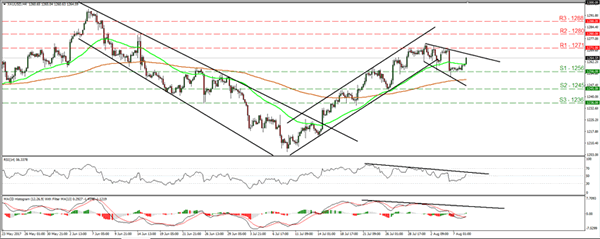Gold prices recovered somewhat during the European morning Tuesday, after ending the previous week on the back foot. The precious metal underperformed throughout most of the week amid an overall risk-on sentiment in markets, evident by major US stock indices like the Dow Jones breaking multiple all-time highs. Gold then took another hit on Friday following the release of upbeat US employment data for July and some optimistic comments on tax reform from the director of the National Economic Council. Without any risk events on the horizon over the next few days, we think that gold may trade quietly for now. The next major market mover for the precious metal may be on Friday, when we get the US CPI data for July.

XAU/USD traded higher during the European morning Tuesday, after consolidating above the key support of 1256 (S1) for the whole day on Monday. Since the 1st of August, the price has been trading within a downward sloping broadening wedge, and thus, we remain flat for now as the wedge may represent just a corrective phase. We need to see an upside escape before we get confident on the resumption of the prevailing uptrend. A break above the upper bound of the pattern could initially aim for the 1271 (R1) key resistance, while a break above that level will confirm a forthcoming higher high and may set the stage for extensions towards the 1280 (R2) obstacle.
Our short-term oscillators support somewhat our view. The RSI rebounded, broke back above 50, and now appears ready to challenge its own downside resistance line. If the indicator breaks above that line at the same time the metal exits the wedge, we believe that the price will have the necessary momentum to overcome the 1271 (R1) zone. As for the MACD, although negative, it bottomed and crossed above its trigger line.

Zooming out to the daily chart, we see that the metal continues to trade in the sideways range that’s been in place since the end of January, between the 1200 and 1300 key barriers. The latest short-term uptrend began from near the lower bound of that range. As such, this increases the likelihood for further near-term advances, perhaps towards upper bound of the range, at 1300.












